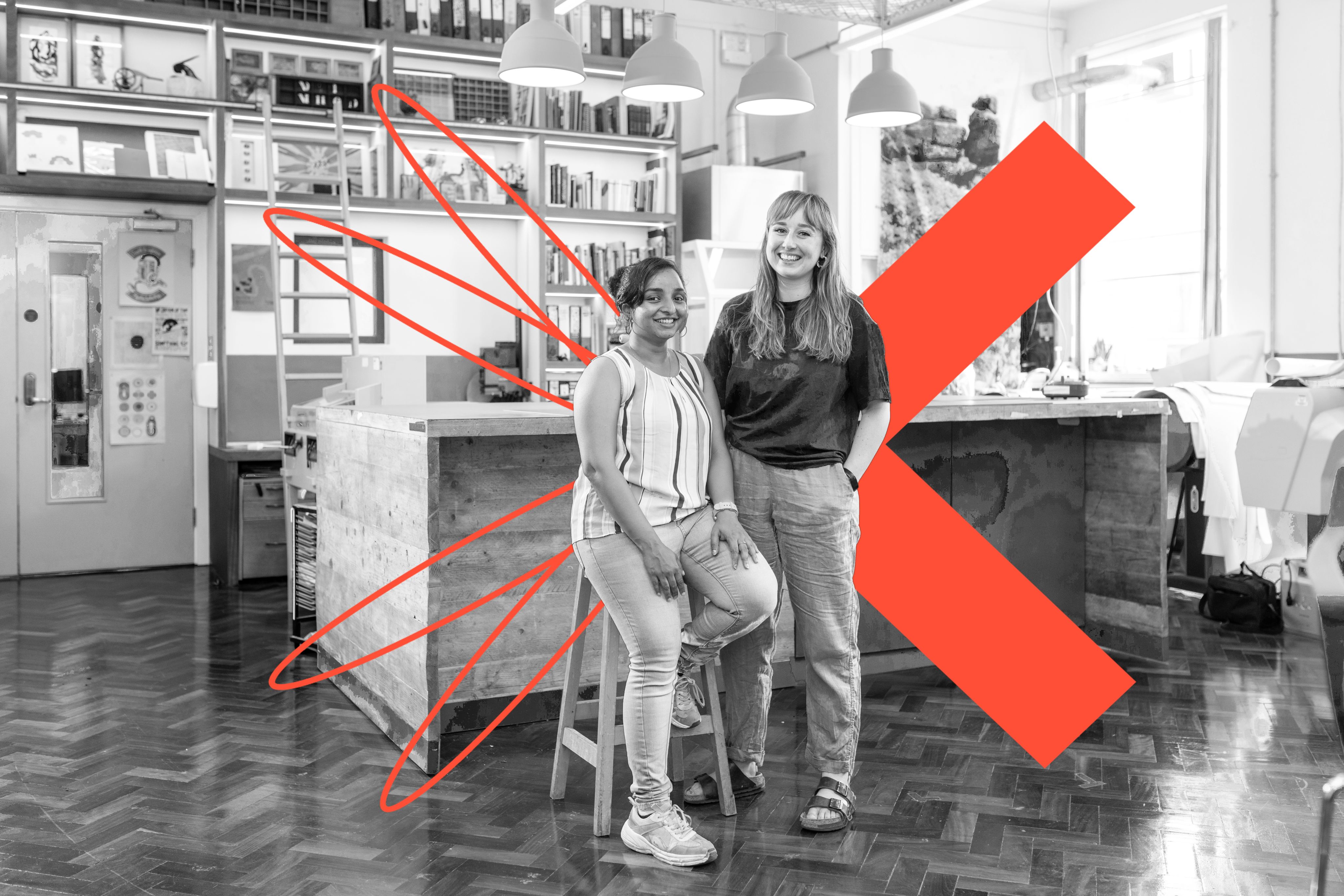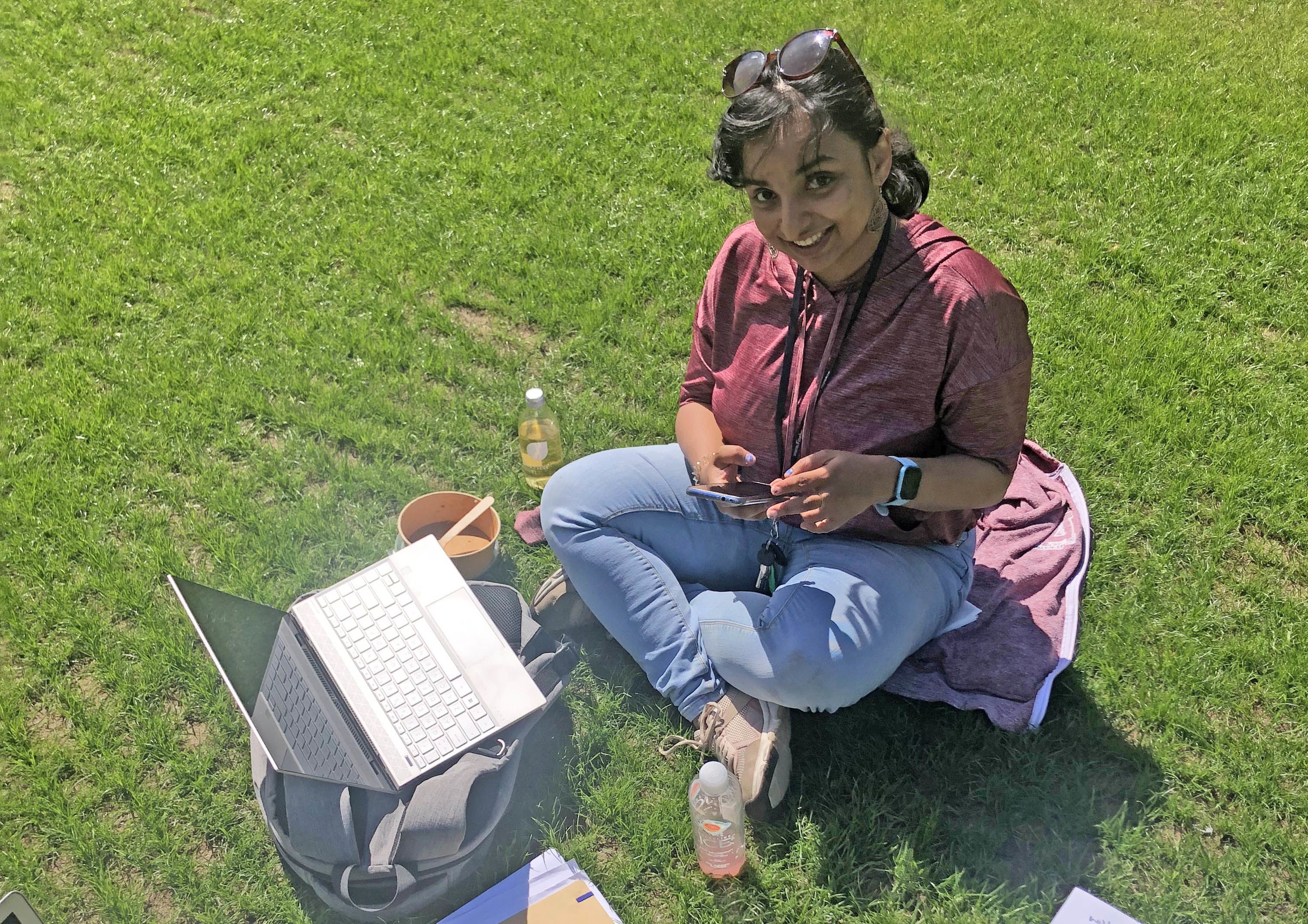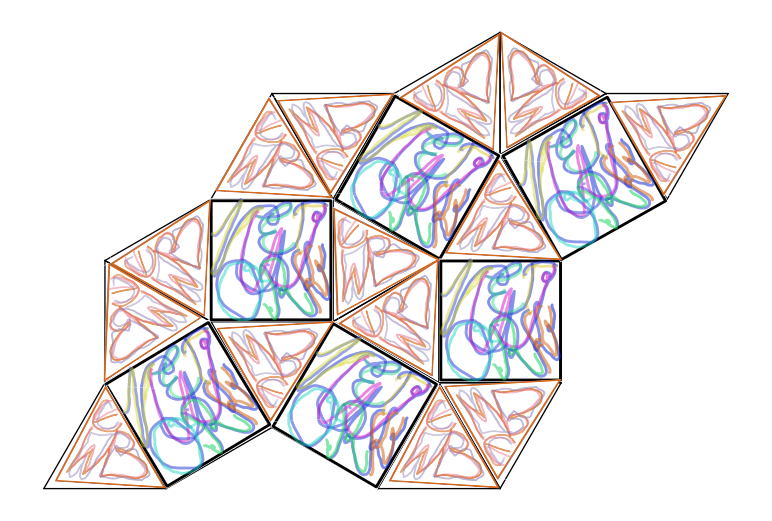Merin and Alice
Postgraduate Researcher Edition, 2022

Merin Joseph, Applied Mathematics Postgraduate Researcher, collaborated with Alice Chandler, Postgraduate Researcher from the School of Performance and Cultural Industries on the Leeds Creative Labs: PGR Edition in 2022. After spending time finding a common language, the pair looked at ways to connect creative interpretations of qualitative data with coding and theoretical mathematical patterns.
What encouraged you to apply to Leeds Creative Labs?
Merin: Being someone in science doing theoretical research, it is quite uncommon to see the practical aspects of the work.
Leeds Creative Labs seemed like a good opportunity to take the interdisciplinary collaboration up a notch by collaborating with art-based research.
Alice: It interested me in a number of different ways! While my research is actually not practice based, I am a practicing artist – I’m interested in material and craft processes, objects and language and what happens when things are juxtaposed, put out of context or into dialogue. My PhD research is a qualitative study exploring the value, impact and sustainability of artist networks in Yorkshire and Humber, with a focus on how visual arts organisations and artists might collaborate to create structures of support. I was particularly drawn to the Braggs' themes: understanding materials and systems relate to both my arts practice and PhD research respectively.
I thought the opportunity to collaborate with someone outside of the arts, would be really valuable for gaining knowledge about reflective and collaborative ways of working.
What was your experience of collaborating?
Merin: Absolutely wonderful, that's the simplest way I can describe this experience. This was an eye opener to different methodologies used in research.
We got to visit each other’s workplaces to realise how wide the work spectrum is.
The most amazing experience in this collaboration was coming across familiar vocabulary, which had different meanings in both our work contexts. Most of our meetings were relaxed brainstorming where casual conversations turned into wonderful ideas.
Alice: We had a great time: so much of it was about finding the commonalities between our disciplines.
We were amazed by the amount of shared language we had – especially when words meant totally different things in each context!
We visited each other’s offices, took a trip to my studio where I showed Merin how to solder silver (and introduced her to studio dog Ralph), went to some material labs at Sheffield University, visited the UoL weave lab where weaver Hannah Robson showed us around, and we went out for food (more than once). We took over several meeting rooms and scribbled all over whiteboards. Basically, we just had lots of great discussions, and I now know so much more about theoretical quasi-crystals and aperiodic tiling than I ever imagined.

Merin in the park working with Alice.
Merin in the park working with Alice.
What changed and what did you produce?
Merin: From our meetings, we agreed we wanted to produce something that reflects both our research. Out of the many questions that we asked one that stuck through most of the ideas we passed was connecting language and patterns in a way that reflects the social aspect.
We went through different paths asking these questions only to realise this opens up more complex questions that need more time to solve.
I would love to solve these questions one day.
Alice: We drew from my interest in ways of creatively interpreting qualitative data, and Merin’s in-depth knowledge about coding theoretical mathematical patterns representative of quasi-crystal structures.
Thinking about how to connect these interests instigated so many questions and ideas around how we could collect interview/spoken data and then explore the structure of the language or audio, to work out if the language could be computer-coded into structured patterns.
In theory, through working with a chemist to make the material the patterned structure denotes, this would form a material representation of the qualitative data. A more visual representation might involve working with a weaver to create the pattern in woven textiles. This idea took us down a lot of different paths, some dead ends, and a lot of “what ifs” and “if we had more time and 10 experts to help us.” We’re still working it all out.

Pathway diagram by Alice and Merin.
Pathway diagram by Alice and Merin.
What was the impact of participating on your research and creative practice?
Merin: A few weeks after Leeds Creative Labs concluded, I happened to go to a Mathematics conference which was on Aperiodic tilings, where they also had an exhibition on different aperiodic displays.
There were many people who worked in the bridge of Maths—Arts. I was happy that because of my experience in Leeds Creative Labs I could relate to the motivation of their work and the challenges they face. Along with that personally, I have noticed that most of the science-based research is conveyed in a way it is only accessible to those from the same background. This exercise with Leeds Creative Labs made me more aware to make my work more accessible.
Alice: The process has been really useful for learning to talk about my research and interests with someone in a completely different discipline, as well as helping me to think methodologically about collaboration. In terms of thinking about the potential of the project, it was exciting to think about the possibility of involving other researchers in the future, eg linguistics, chemists, or weavers, or engaging public participants.
What's unique about the Leeds Creative Labs?
Merin: Leeds Creative Labs is not a traditional PhD experience that you would expect.
The way Leeds Creative Labs is structured, giving importance to collaboration rather than to the output, gave the flexibility to explore more different aspects of our ideas and have a wider perspective.
Alice: Leeds Creative Labs really encourages you to focus on the process of collaborating, and to ensure that the ideas you develop together are really co-created, ie not just an illustration of the other partners' practice – this is such a valuable skill for research in the arts and generally.
There is no output required which means you can really take the process where you want and be flexible.
It was useful to have the opportunity to present our ideas in an informal way, as it really motivated us to reflect on all the ideas we had developed.
What’s next?
Merin: As Alice mentioned we are in different stages of our respective PhDs with me writing up and she is busy with her transfer. But we are planning to continue this at a natural and more flexible pace as for one we enjoyed this process and what we developed seems to have a much wider reach and potential than we thought of.
Alice: We are both at quite different stages of our PhD: Merin’s writing up and I’m just finishing first year, about to take the transfer before embarking on a year of data collection! I’ve been working on a project with the Centre for Cultural Value, undertaking an analysis of their Collaborate programme, which funds collaborative projects between academic and cultural sector partners – pretty relevant to Leeds Creative Labs! I’m writing an article about it for Arts Professional, so that should be out soon.
About the Postgraduate Researcher Edition
In this iteration we welcomed a collaboration among postgraduate research (PGR) students from the Bragg Centre and practice-based PGR students from the Faculty of Arts, Humanities and Cultures. This iteration developed under the Inspired by Bragg programme. Six students took part in this iteration. To find out more, read the Medium article Inspired by Bragg: Meet the PGR students working at the centre point of art and science.
More stories
